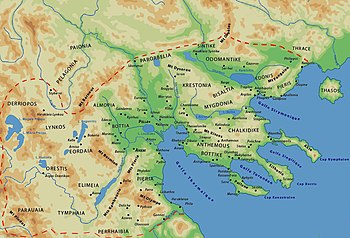Eordaea
This article needs additional citations for verification. (September 2011) |

Eordaea (Greek: Ἐορδαία) was an ancient kingdom and later an administrative region of the kingdom of Macedon. It was part of the ancient geographical region of Upper Macedonia and was located south of Lynkestis, west of Emathia, north of Elimiotis and east of Orestis.[1] The modern province and municipality Eordaia located in Western Macedonia were named after the ancient kingdom and region. It stretched in the basin of the current homonymous municipality, also in the southern part of the municipality of Amyntaio and the western part of the municipality of Edessa, Greece.
The capital of Eordaea was the city of (el) (Greek: Εορδαία, κείμενη της λίμνης), which was mentioned by many historians and geographers of antiquity.
History[]
The history of Eordaea stretches long before 2000 BCE when the first Greeks, known as the Mycenean Greeks, began to inhabit this area. Remnants of exploited copper mines from 2700 up until 1200 BCE strongly indicate that the Greeks inhabited Eordaea for many years. Iron mines have also been exploited in the Eordean region.
Recent discoveries[]
Within a 50-year period, paleontologists and archaeologists have made many discoveries due to the industrial development of the Eordean countryside. In particular, the skeletal fossils of a prehistoric mammoth, a prehistoric elephant, and Stone Age tools have all been found within the province of Eordaea. These finds add to knowledge on the variety of animal species and human artifacts from the region of Western Macedonia.[citation needed]
Towns[]
Many ancient towns of Eordaea are mentioned and many archaeological sites have been examined on the past decades, certainly around the Vegoritida lake, but it is difficult to distinguish their names.
The most significant towns, according to Ancient Greek, Roman and Byzantine Greek writers, were:
Notable people[]
- Ptolemy I Soter. He is the most known notable person of ancient Eordaea. He was a distinguished General of Alexander the Great. After the death of Alexander the Great, Ptolemy became Pharaoh of Egypt and founder of the Ptolemaic dynasty which ruled Egypt until 30BC.[2][3][4][5]
- Lagus. Father of Ptolemy I Soter
- Peithon. Satrap of Alexander the Great
- Aristonous. Bodyguard of Alexander the Great
References[]
- ^ Dimitrios C. Samsaris, Historical Geography of the Roman province of Macedonia (The Departmement of Western Macedonia today) (in Greek), Thessaloniki 1989
- ^ Jones, Prudence J. (2006). Cleopatra: A Sourcebook. University of Oklahoma Press. p. 14.
They were members of the Ptolemaic dynasty of Macedonians, who ruled Egypt after the death of its conqueror, Alexander the Great.
- ^ Pomeroy, Sarah B. (1990). Women in Hellenistic Egypt. Wayne State University Press. p. 16.
while Ptolemaic Egypt was a monarchy with a Greek ruling class.
- ^ Redford, Donald B., ed. (2000). The Oxford Encyclopedia of Ancient Egypt. Oxford University Press.
Cleopatra VII was born to Ptolemy XII Auletes (80–57 BCE, ruled 55–51 BCE) and Cleopatra, both parents being Macedonian Greeks.
- ^ Bard, Kathryn A., ed. (1999). Encyclopedia of the Archaeology of Ancient Egypt. Routledge. p. 687.
During the Ptolemaic period, when Egypt was governed by rulers of Greek descent...
Coordinates: 40°30′00″N 21°40′00″E / 40.5000°N 21.6667°E
- Upper Macedonia
- Geography of ancient Macedonia
- Western Macedonia geography stubs
- Ancient Macedonia geography stubs
